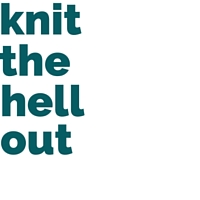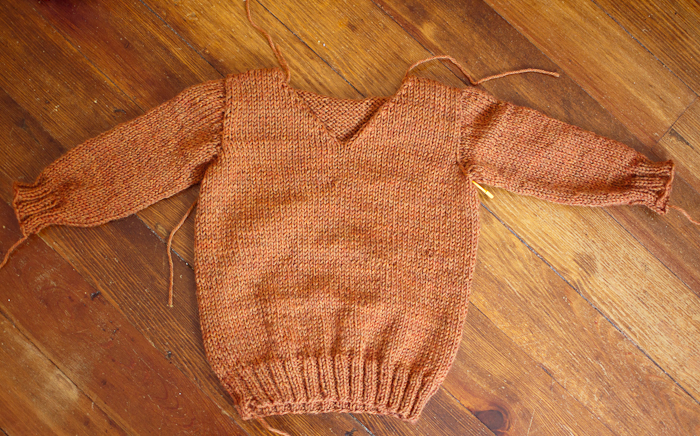I adore whipping up tiny kiddo knits. They’re so cute, I can hardly stand it. This one is no exception. I’m making the Little Joey Kangaroo Hoodie, but I’m sticking some heavy modifications in it. I’m knitting it in the round, drastically altering the armhole shaping and shoulder shaping, and doing the sleeves from the top down with short rows. The pattern is more of a rough guide at this point.
When is a pattern no longer the original pattern and your own? I’ve heard people say things like, “make 3 changes in a pattern and it’s your own,” but that seems far far far too vague, and probably not enough changes to call something your own and produce a pattern for it. For something like this, I would never try to write something up that’s similar and publish it as my own, even if my construction is mostly different. It seems like the difference between following the spirit of the law, versus following the letter of the law. I guess I’m aiming to follow the spirit of the law here, even though I don’t know what the actual “letter of the law” is when it comes to this level of finesse regarding knitting copyright.
What are your guidelines? I come across patterns that are SUPER similar in Ravelry all the time, by different designers. I’m betting most of this is pure coincidence as many of us probably use similar reference tools, like Barbara Walker’s Treasury of Knitting books, and Vogue Stitionary books. I purchased all four of Barbara Walker’s books last year and saw many stitch patterns that inspired designs. Nevertheless, I was rather floored when someone commented that my Summer Slice socks looked like Wendy D. Johnson’s Peace Socks. Yep. Almost the same darn socks. Guess we both used the Stag Lace from the first edition of Vogue Stitionary.
I’m not alone. These garter stitch mitts vary only slightly from these, save some short rows for the thumbs. These three baby sweaters all seem to be using the same cable pattern as a reference. These are just the few examples I could remember. There is nothing new under the sun! Sweaters, socks, hats, mittens, etc. can only be constructed in a variety of ways, with a variety of stitch patterns, and different kinds of fit. I guess I’m just feeling philosophical. I’d love some opinions on this matter, especially if you dabble in design.




You raise good questions. I will be interested in seeing people’s thoughts on that. A problem/difficulty I foresee is if someone has published and claims copyright to the pattern. Perhaps it is important, in the event the other designer is litigious, to ensure you have your notes and can show when you designed and how you came to your pattern.
I haven’t dabbled in design yet, but I just our this conversation has been popping up at the knitting group recently.
It’s a tough call. Like you said, sweaters, socks, etc have a few constructions, but from there it’s just variations. My first thought would be “Did you keep the spirit of the original pattern?” And there we go again, “spirit of a pattern” would be very hard to define!
I won’t call it mine if I followed a pattern. All of my hats, for example, are mine for sure. I used the pi thing lol. However, I will “borrow” ideas. I used Repeat Crafter Me’s ribbed brim idea (not her stitch count or any of it). I do braids on hats because I see them around. Things like that. I usually only “copy and claim” if the original is not crochet. If I try to replicate a knitting pattern, which I haven’t yet, I would say it’s my crochet pattern, inspired by so-and-so’s knitting pattern. I’m good with staying away from other people’s things other than some ideas and such. 🙂
Generally I think if you’ve changed one or more of the things that made the pattern unique, it is now a new pattern. If the pattern isn’t especially unique (i.e. most patterns), then you’re probably not going to change much without accidentally turning it into another pre-existing pattern. As long as you’re not copying wording, pictures, or diagrams/charts, it’s yours.
It seems that in knitwear design, like fashion, changing a pattern or a style a little bit, but keeping the essence of the original design is An Homage, not copying. This is a compliment to the designer (“your work is so great that I want to put work and creativity into it to make it even better”) so long as the “copy-er” gets no financial benefit from using their original pattern. However, the issue comes when money gets involved. Is it different enough that you can make it a separate pattern and sell it without giving credit or money to the original designer? That “different enough” is tricky, and generates huge lawsuits in other creative industries (like music and software design). However, I think with knitwear design, it doesn’t have to be too terribly different (how different is too terribly different? I have no clue). After all, how much can you really change a basic sweater?
I don’t think something has to be REVOLUTIONARY to be “different enough,” it just has to be a new take on an old pattern.
That being said, I hate when I have a great idea for a pattern, congratulate myself for being so clever, and then find something almost exactly the same that already exists. Darn!
Hahaha. Yeah! That’s how I felt when someone pointed out that my Summer Slice pattern looked like the Peace Socks. Now, I haven’t gotten my hands on Wendy D. Johnson’s pattern, but I’m betting the writing of them is fairly different. We can’t always be revolutionary about our patterns. I have no intention of writing up my mods as a different pattern, but it’s been an interesting question to muse about.
As far as I remember from the discussions of copyright during my time at FIDM, the only thing that actually falls under the copyright is the written instructions. Meaning, the garment and design aren’t actually part of the copyright, just the words written to create the garment. That being said, your statement of following the idea of the law rather than the letter is more accepted in general. Even though you possibly could legally get away with writing a pattern for something you modified, it’s probably not the best idea to risk it because it “gives out bad juju” (I could not come up with another way to say it).
Think of it as knock-offs versus counterfeits. Forever 21 doesn’t get raided because they take the inspiration from the big designers and make a cheaper version because they don’t try to pass it off as the real thing. Large shipments of poorly made fakes get destroyed in the port all the time because they aren’t the real thing but trying to claim they are. I don’t know if that makes sense, but that’s how I understand it to work.
I read the copyright group at ravelry from time to time and that is the general understanding there too. You are on the legal side if you write down the pattern on your own (and I think the layout should not look too similar). Besides that there is the moral standpoint. I personally think a significant change in the patter justifies publishing it under your own name. Most likely the author of the original pattern got his or her influences from somewhere else too. I mean, mankind is knitting jumpers for ages and taking an idea and improving it is actually what made our society develop. What if the person that invented the wheel would have had a copyright for it?
That is very interesting. There are lots of times when I have been able to look at a pattern, figure out how to make it, and sometimes I’ve done it. For example a hat that I made http://www.ravelry.com/projects/knitthehellout/n-cap-wannabe was inspired by the N-Cap (a pattern only available in Japanese), was easy to figure out how to make by looking at the pattern picture. That reminds me…said hat is also EXTREMELY SIMILAR to the much lauded Wurm pattern.
From what you’ve written it looks like you’ve come up with a totally differend construction method, so I’d second hasretnakislari. A hooded sweater will always be similar to other hooded sweaters. But if you have a different way of constructing it, work out the numbers on your own and write the pattern instructions from scratch (not just plunk your own numbers into the original version) I’d say it’s a new pattern.
I agree. Maybe someday I’ll write up a pattern for a kiddo hooded sweatshirt that’s completely different.
it’s an interesting question….there are lots of patterns that are just modifications. and lots that just past a particular stitchpattern onto a basic shell of a sweater. and this year there is the very popular color block and stripe added to garments and accessories. I quess they are all patterns but would I buy the pattern?? no probable not because I could read the picture and make my own if I wanted to. when I buy a pattern it is to discover an interesting knitting technique or unusual construction or a pattern stitch that I cannot figure out on my own. these are the pattern I like to buy.
Right. It’s hard to justify buying the pattern if you can just study it and replicate that. I think that’s 100% fine to do for yourself as a personal knitter, but I get tetchy when I think about then writing that pattern up and distributing it, whether for free or for sale.
So tricky! I’ve wondered this same thing about some of the Mod Monday posts that Julie writes up. If you take a colourwork motif or lace pattern from a scarf or mitten, and then turn it into a sweater, that strikes me as your own pattern.
I guess it depends on intent. Being inspired by a pattern and interested in taking the idea and making your own version is, I think, different than using a pattern as a template to create something quite similar and then saying it’s yours (which is definitely not what you’re doing, obviously). In general, I think there’s a pretty good understanding as to what makes designs unique – whether it’s shaping or stitch patterns or constructions – and there’s definitely an appreciation for extensive mods.
I am really looking forward to seeing this little fox hoodie knit up.
What a interesting discussion.
If I was to follow the “3 changes” rule then everything I make would be classed as my own pattern just due to the changes I make by accident.
I would never be brave enough to design anything myself though and always gift credit to the pattern I’ve used when I post a blog.
This WAS interesting discussion! I learned a lot!
It is just my opinion, but if I modified an existing pattern, I would publish it as a free one (if there is demand!) mentioning the original pattern that inspired it! Otherwise, if it is coincidence, I would publish it as my own! I’ve heard other designers mentioning people who tell them they copied a pattern. That must be a little difficult to receive such comments… 🙁 In any case, that little sweater looks really cute!
In a google search I did about pattern changes, I came across this post and your comment here. This exact thing happened to me tonight. I modified an existing pattern to fit what I was trying to accomplish (changed a “block” pattern to fit inside a hoop) and published it as a free pattern mentioning the original (which is also a free pattern). And then I was contacted by the designer; she was very rude and even wished ill-will over me because of it. It’s really demotivating and make me never want to share with the crafting community ever again.
Yeah, I’m facing a similar dilemma in the reconstruction of a pair of yoga socks distributed by Patons for their Kroy Sox. I didn’t like the original pattern very much and all that I used of it was the stitch count (a standard 64 that increased to 72 to shape the heel opening and decreased back down to 64 for the foot) and the rows of ribbing for the cuff, heel and the toe opening, but I changed the ribbing from 1×1 to 2×2, added a cable pattern from my own experimentation that extended all the way down the instep (the original ribbed pattern stopped and started again after 1×1 ribbing for the heel) and I changed the gauge a bit since the original pattern was too loose in the pattern gauge. I was considering writing it up as a free pattern and crediting the original as inspiration, but not sure if I would get in trouble 🙁
I have experienced this same phenomenon recently when a customer on Ravelry accused me of copying another design. I was floored. It was very similar and the edging was the only design element that was different. But I had designed this entire piece myself, using freely avalable stitches and honestly, I felt a little bullied when more people accused me of copying. I removed the pattern eventually, but in retrospect, I think I should have stood my ground.
I want to design and publish my own patterns and I am struggling with this question. Where is the line between original / inspired by and copied. What complicates the issue, is that some patterns include modifications to make it your own. I would love to hear what the designers have to say about it and how to make room for new designers without compromising their financial and personal stakes.
http://www.tabberone.com/Trademarks/CopyrightLaw/Patterns.shtml. Read this..it explains very clearly. I almost always design my own patterns one way or another. Usually because the patterns I see aren’t exactly what I want. I haven’t published a knitting pattern but I’ve designed, published and for years taught beaded jewelry design and frankly find this whole bough ha ha ridiculous. If I publish a pattern design with instructions can I honestly expect people are not going to make it? Really? Once I design and teach or publish a pattern to make something I’ve given it to the world. Move on. Feel proud that others like your work enough to want to reproduce it. One of my designs has been used in Bead and Button pubs no less that five times. Wow!! It’s popular. I haven’t made it since it’s been published. My advise is if you are going to stress over who is going to make your design, don’t publish it. Once you do, move on. If you are trying to make a living from your work, publish excellent designs and directions. Make them so clear that anyone can be successful. That way people will buy your patterns because of the quality of the teaching. Also, I always made way more money teaching than selling patterns or finished pieces. Find your niche, enjoy it and don’t try to control what your can’t. Controlling the use of your patterns, either in paper form or the finished product is like trying to hold water in your hands. Just my two cents.